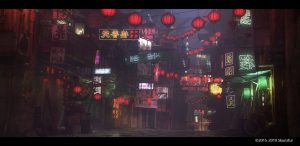
“Cities are embodiments of technocratic modes of being and knowing.”
Technology and (Chinese) Ethnicity written by Darren William Davis highlights some important changes in the today’s science fiction genre in film, with special emphasis on how they are ‘sinicized’ or influenced by Chinese culture. He begins with the description of Chinatown as a popularised setting for many such films and discusses the reasons behind why it has become an ideal background to set futuristic plots, which show the remediation of ethnicity by technology. Chinatown is often used as a representation of high-density multiculturalism and is a prevalent urban setting to invoke our imagination, with its claustrophobic alleys housing not just people of Asian descent but also their many symbols, like feng shui, martial arts, opium trade and dialects. The ethnic display and its articulation, according to Davis, represent the verisimilitude of Chinatown imagery, while highlighting the ‘technological hypermobility of Asian migration and habitation’.
He furthers his argument on the use Chinese ethnicity through two films, Ghost in the Shell (1995) and Innocence (2004). He uses the logic behind the plot of the films to connect them to their urban settings. He also talks about Hong Kong as an emerging background to show the modern IT city, discussing the possible reasons behind doing so. Just like Chinatown, but much more metropolitan, Hong Kong embodies an advanced technological future in a regionally condensed infoscape. It shows today’s fast pace and link to the techno-world while also being connected to its mystic Chinese roots. Davis calls Hong Kong the ‘functional equivalent to the Shanghaied City of Angels’, illustrating its extremely international, micro-nation-like quality in the films that it is often showcased in.
Both his examples, Chinatown and Hong Kong, have a unique and highly fascinating purpose to serve. There is a reason why these two locations have long been the muse of many filmmakers. Portraying science fiction, and the new age, requires visualising information as something that exists in a physical setting, and is not just a virtual phenomenon. These places condense and immense amount of culture – not just Chinese but various others – into an extremely small urban space and make their recognisable signs extremely prominent. Chinatown here serves the purpose of not being a tourist spot, but rather an institution, that combines the exotic with the ordinary. What may seem very odd somewhere else might be mundane here. In Hong Kong, information itself is somehow given an architectural form, something that makes it easy for the viewer to be able to envisage, in its economic and cultural progression. Both worlds are very real, and yet have qualities that might as well be only found in fiction. Both places are the prime examples of an urban space that is connected to its roots and ethnicity while being highly influenced by a high-tech new age lifestyle. They represent endless possibilities, while projecting ‘escape’, and dreams of a better future for the people who become a part of it.
“The Sinicization of science fiction begins by marriage of Asian superstition with urban cyberculture”.
By: Anahita Garg
UID: 3035557856